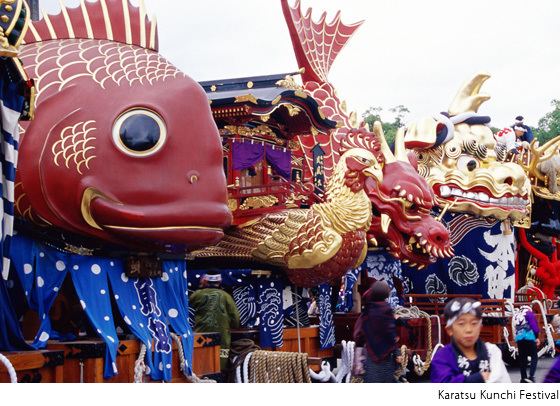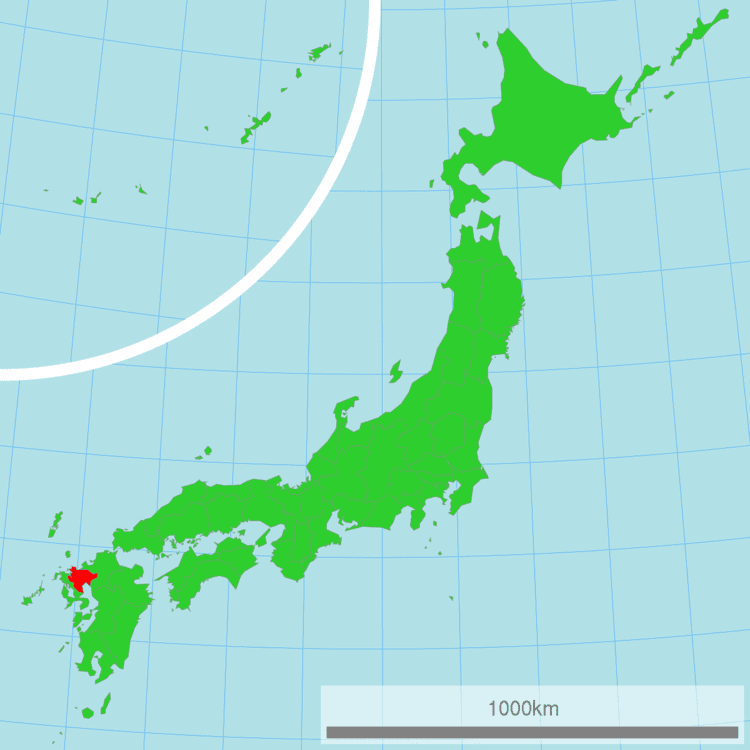Country Region Governor | Area 2,439.58 km2 Capital Saga (city) | |
Destinations Colleges and Universities Saga University (Saga), Nishikyushu University (Kanzaki), Himeji Hinomoto College (Kanzaki), Kyushu Ryukoku Junior College (Tosu) | ||
Population 853,363 (Mar 31, 2012) | ||
Map of Saga Prefecture
Saga Prefecture (佐賀県, Saga-ken) is a prefecture in the northwest part of the island of Kyushu, Japan. It touches both the Sea of Japan and the Ariake Sea. The western part of the prefecture is a region famous for producing ceramics and porcelain, particularly the towns of Karatsu, Imari, and Arita. The capital is the city of Saga.
Contents
- Map of Saga Prefecture
- My commute to work in saga prefecture japan
- Saga prefecture the northern area of saga city
- History
- Feudal period
- Timeline
- Geography
- Plains
- Mountains
- Rivers and lakes
- Seas
- Peninsulas
- Islands
- Forests
- Caves
- Land use
- Climate
- Municipalities
- Cities
- Towns
- Metropolitan areas
- Economy
- Banks
- Universities
- Demographics
- Air
- Rail
- Road
- Culture
- Language
- Saga International Balloon Fiesta
- Karatsu Kunchi
- Kashima Gatalympics
- Imari Ton Ten Ton Festival
- Sports teams
- Tourism
- Notable people
- The Seven Wise Men of Saga
- References

My commute to work in saga prefecture japan
Saga prefecture the northern area of saga city
History

In ancient times, the area composed by Nagasaki Prefecture and Saga Prefecture was called Hizen Province. The current name dates from the Meiji Restoration. Rice farming culture has prospered here since ancient times, and vestiges can be seen at the ruins of Nabatake in Karatsu and the Yoshinogari site in Yoshinogari.
Feudal period
From the Kamakura period to the Muromachi period, it is thought that over 100 feudal clans existed. Also exerting great influence during this time was a samurai clan operating along the Genkai Sea called the Matsuratō. Upon entering the Sengoku period, the Ryūzōji clan expanded their control to include all of Hizen and Chikugo Provinces, and part of Higo and Chikuzen Provinces. After the death of daimyō Takanobu Ryūzōji, Naoshige Nabeshima took control of the political situation, and by 1607 all of the Ryūzōji clan's domain was under the control of the Nabeshima clan.
In the Edo period this area was called the Saga Domain (佐賀藩 Saga-han), and it included three sub-domains: the Hasunoike, Ogi and Kashima Domains. Also within the current borders of Saga Prefecture during this time were the Karatsu Domain (唐津藩 Karatsu-han) and two territories of the Tsushima-Fuchū Domain (対馬府中藩 Tsushimafuchū-han). Saga Domain and its sub-domains continued to be ruled by the Nabeshima clan, its various illegitimate family lineages and members of the former Ryūzōji clan, and politically the area was relatively stable. However, the cost of defending Nagasaki was increasing and, difficult from the start, the financial situation was worsened by the great Kyōhō famine and the Siebold Typhoon of 1828. Nevertheless, due to the large area of reclaimed land from the Ariake Sea arable land was able to increase significantly and by the 1840s the annual koku of Saga Domain increased to about 670,000, twice that of 200 years before.
Around the middle of the 19th century, Naomasa Nabeshima strove to set right the domain's financial affairs, reduce the number of government officials, and encourage local industry such as Arita porcelain, green tea, and coal. Also, thanks to the proximity of the international port of Nagasaki, new technologies were introduced from overseas, such as the reverberatory furnace and models of steam locomotives.
After the Boshin War, many people from Saga Domain assisted in the Meiji Restoration. In the Meiji era the modernization of coal mines in Kishima and Higashimatsuura districts, among others, progressed bolstered by the construction of railroads.
Timeline
Geography
Kyushu's smallest prefecture, Saga, is located on the northwest corner of the island, bordered by the Genkai Sea and the Tsushima Strait to the north and the Ariake Sea to the south. Saga's proximity to mainland Asia has made it an important gateway for the transmission of culture and trade throughout Japanese history. Largely rural outside of the two largest cities of Saga and Karatsu, agricultural and forested lands comprise over 68% of the total prefectural land area. There are six prefectural parks and one quasi-national park in Saga.
Plains
Mountains
Rivers and lakes
Seas
Peninsulas
Islands
Forests
Caves
Land use
Total area: 2439.31 km2
As of March 31, 2008, 11% of the total land area of the prefecture was designated as Natural Parks, namely the Genkai Quasi-National Park and Hachimandake, Kawakami-Kinryū, Kurokamiyama, Sefuri-Kitayama, Taradake, and Tenzan Prefectural Natural Parks.
Climate
Saga Prefecture has a mild climate with an average temperate of about 16 °C (61 °F).
Municipalities
As of October 1, 2007, there are 10 cities, six districts, and 10 towns in Saga Prefecture, a total of 20 municipalities. As a part of the Great Heisei Merger, the number of municipalities has decreased since January 1, 2005. On March 20, 2006 the village of Sefuri merged with the city of Kanzaki, leaving Saga with no more villages.
Cities
Ten cities are located in Saga Prefecture:
Towns
These are the towns in each district:
Metropolitan areas
Economy
Agriculture, forestry, and coastal fisheries form a large portion of the prefectural economy. Regional agricultural specialties include Saga beef, onions, and strawberries. The prefecture is the largest producer of mochigome (sticky rice) and greenhouse mandarin oranges in Japan.
According to 2002 figures, regional trade exports are focused primarily towards North America (29.3%), Western Europe (26.1%), and the Newly Industrializing Economies of South Korea, Taiwan, Hong Kong and Singapore (19.9%). Imports come principally from North America (40.6%), the ASEAN nations (23.3%), and the People's Republic of China (12.2%).
Banks
Universities
Demographics
As of 2002, the census recorded a population 873,885 in Saga. Of these, 15.9% were aged 0–14, 62.7% were age 15–64, and 21.4% were over 65 years old. There were 3,596 foreigners (0.4%) and 307 exchange students (0.03%) living in the prefecture.
Air
Rail
Major stations in the prefecture include Saga Station, Tosu Station, Karatsu Station and Imari Station. The new Kyushu Shinkansen line stop at the Shin-Tosu Station.
Road
Culture
Arita, Imari and Karatsu are famous for the beautiful porcelain that is created there. The top porcelain houses in the country are located in these areas, including Imaemon Porcelain, Genemon Porcelain and Fukagawa Porcelain.
Language
Saga-ben (Saga-dialect) is Saga's own variation of Japanese.
Saga International Balloon Fiesta
The Saga International Balloon Fiesta is held at the beginning of November every year just outside Saga City along the Kase River. This is a very popular event and attracts competitors from all over the world.
Karatsu Kunchi
The Karatsu Kunchi is held at the beginning of November in Karatsu City. This is Saga's most famous festival and attracts around 500,000 visitors every year.
Kashima Gatalympics
The Kashima Gatalympics are held every May–June in the city of Kashima. This event involves playing a variety of sports in the mudflats of the Ariake Sea. The Gatalympics are not held if the weather is raining.
Imari Ton-Ten-Ton Festival
The Imari Ton-Ten-Ton Festival is held for 3 days every year near the end of October. Located in Imari City, the festival is one of the three great fighting festivals in Japan. In the festival a crashing battle takes place between the two huge portable shrines, the Ara-mikoshi and the Danjiri. The name "Ton-Ten-Ton" represents the sound of drums used in the festival.
Sports teams
Teams listed below are based in Saga Prefecture.
Football (soccer)
Volleyball
Tourism
Karatsu, with its fine castle, is a popular tourist destination in Saga. The remains of a Yayoi village in Yoshinogari also attract large numbers of sightseers. Another place to visit is Yūtoku Inari Shrine, one of Japan's three biggest Inari shrines.
Notable people
The Seven Wise Men of Saga
"The Seven Wise Men of Saga" is the name given to these seven men from Saga, each of whom have made a significant contribution to the modernisation of Japan. Their contributions began in the last days of the Tokugawa Shogunate, and continued into the Meiji Restoration. Even today, this era shines impressively in Saga's history.
